Natural Hazards
Tsunami
Prepared by ICoD – Euro-Mediterranean Centre on Insular Coastal Dynamics (Valletta, Malta) & the Editorial Board

A Tsunami (Japanese word meaning ‘harbour wave’), one of nature’s most awesome forces, is a series of ocean waves of extremely long wave length and long period, generated in a body of water by an impulsive disturbance that displaces the water.
A Tsunami consists of 5-6 waves of which the first wave is small and called the gentle wave. The second and the third waves are the high waves and most destructive.
A tsunami (Japanese word meaning harbour wave), one of nature’s most awesome forces, is a series of ocean waves of extremely long wave length and long period generated in a body of water by an impulsive disturbance that displaces the water. A Tsunami consists of 5-6 waves of which the first wave is small and called the “gentle wave”. The second and the third waves are the high waves and most destructive.
At sea, tsunami waves are less than 60 cm high, not even perceptible from ships or planes. By contrast, their length is often more than 160 km long, much greater than the water depth over which they travel. A comparison between the characteristics of wind waves and tsunami waves is given in Table 1. Where the ocean is over 6,000 m deep, unnoticed tsunami waves can travel at the speed of a commercial jet plane, over 800 km per hour. They can move from one side of the Pacific Ocean to the other in less than a day. This great speed makes it important to be aware of the tsunami as soon as it is generated. Tsunamis travel much slower in shallower coastal waters wherefore their wave heights begin to increase dramatically.
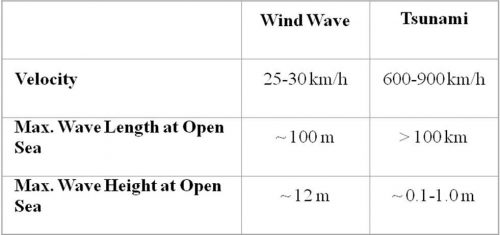
Generation of Tsunamis
Once the event which initiates the tsunami occurs the potential energy that results from pushing water above mean sea level is then transferred to horizontal propagation of the tsunami wave (kinetic energy). The return of the sea level to its normal position generates a series of waves propagating in all directions from the initially deformed area.
Propagation of Tsunamis The speed at which the tsunami travels depends on the water depth. If the water depth decreases, tsunami speed decreases. In the mid-Pacific, where the water depths reach 4.5 kilometers, tsunami speeds can be more than 900 kilometers per hour. Refraction and diffraction of waves are important to the tsunami propagation.
Refraction Consider progressive waves with wavelengths much larger than the water depths over which they propagate. These are called shallowwater or long waves. Because the waves are long, different parts of the wave might be over widely varying depths (especially in coastal areas) at a given instant. As depth determines the velocity of long waves, different parts travel with different velocities, causing the waves to bend, and this is called wave refraction. (Shallower the water depth, less is the velocity.)
Diffraction Diffraction can be considered as the bending of waves around objects. It is this kind of movement that allows waves to move past barriers into harbors as energy moves laterally along the crest of the wave. Offshore and coastal features can therefore determine the size and impact of tsunami waves. Reefs, bays, entrances to rivers, undersea features and the slope of the beach all help to modify the tsunami as it attacks the coastline. When the tsunami reaches the coast and moves inland, the water level can rise many meters. In extreme cases, water level has risen to more than 15 m for tsunamis of distant origin and over 30 m for tsunami waves generated near the earthquake’s epicenter. Since the first wave may not be the largest in the series of waves, one coastal community may see no damaging wave activity while in another nearby community destructive waves can be large and violent. The flooding can extend inland by 300 m or more, covering large expanses of land with water and debris.
There is no such thing as a typical tsunami, each one is different. However, tsunamis are collectively unique in the amount of energy they contain, even when compared to the most powerful wind waves.
However, with respect to generation mechanisms, a tsunami can be classified as earthquake generated, volcano generated, landslide generated and impact (such as asteroids) generated tsunamis.
They can also be classified as distantly generated tsunamis and local tsunamis with respect to the distance of the coastal area affected and the generation location.
When a tsunami travels a long distance across the ocean, the sphericity of the Earth must be considered to determine the effects of the tsunami on a distant shoreline. Waves which diverge near their source will converge again at a point on the opposite side of the ocean. An example of this was the 1960 tsunami whose source was on the Chilean coastline, 39.5S., 74.5 W. The coast of japan lies between 30 and 45N. and about 135 to 140 E., a difference of 145 to 150 longitude from the source area. As a result of the convergence of unrefracted wave rays, the coast of japan suffered substantial damage and many deaths occurred.
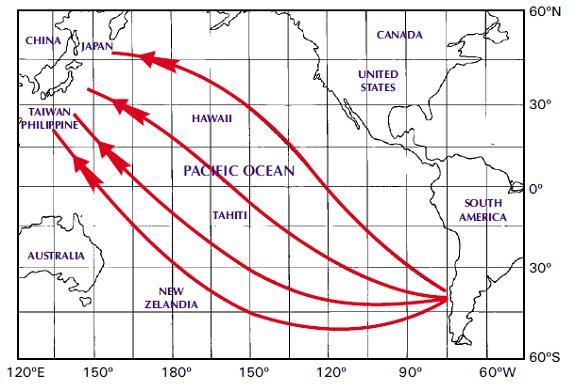
As a tsunami approaches a coastline, the waves are modified by the various offshore and coastal features. Submerged ridges and reefs, the continental shelf, headlands, the shapes of bays, and the steepness of the beach slope may modify the wave height, cause wave resonance, reflect wave energy, and/or cause the waves to form bores which surge onto the shoreline.
Ocean ridges provide very little protection to a coastline. While some amount of the energy in a tsunami might reflect from the ridge, the major part of the energy will be transmitted across the ridge and onto the coastline. The 1960 tsunami which orignated along the coast of Chile is an example of this. That tsunami had large wave heights along the entire coast of Japan, including the islands of Shikoku and Kyushu which lie behind the South Honshu Ridge.
Locally generated Tsunamis
When a locally generated tsunami occurs, it impacts coastal areas a very short time after the event which produced the tsunami (earthquake, submarine volcanic eruption or landslide). Lapses as short as two minutes have been observed between the earthquake’s occurrence and the tsunami arrival to the closest shore. Because of this, a tsunami warning system is useless in this type of event and we should not expect instructions from an established system to react and keep us safe from the possible tsunami impact. This operation incapability of the warning systems is further increased by the communications and systems collapse generated by the earthquake. Hence, it is necessary to prepared in advance a proper response plan in case of a tsunami.
The impulses that create tsunamis can originate from landslides, volcanoes and impacts of objects from outer space (such as meteorites, asteroids, and comets), but mostly, submarine earthquakes.
Generation of Tsunamis
Once the event which initiates the tsunami occurs the potential energy that results from pushing water above mean sea level is then transferred to horizontal propagation of the tsunami wave (kinetic energy). The return of the sea level to its normal position generates a series of waves propagating in all directions from the initially deformed area (Figure 1).
Tsunami propagation
The speed at which the tsunami travels depends on the water depth. If the water depth decreases, tsunami speed decreases. In the mid-Pacific, where the water depths reach 4.5 kilometers, tsunami speeds can be more than 900 kilometers per hour. Refraction and diffraction of waves are important to the tsunami propagation.
EARTHQUAKE GENERATED TSUNAMI
Earthquakes generated tsunamis occur when the sea floor abruptly deforms and displaces the overlying water from its equilibrium position (Figure 1). However, not all earthquakes generate tsunamis. To generate a tsunami, the fault where the earthquake occurs must be underneath or near the ocean, and cause vertical movement of the sea floor (up to several meters) over a large area (up to a hundred thousand square kilometers). Shallow focus earthquakes (with a depth less than 70 km) along subduction zones (where an oceanic plate slides under a continental plate or another younger oceanic plate) are responsible for most destructive tsunamis.
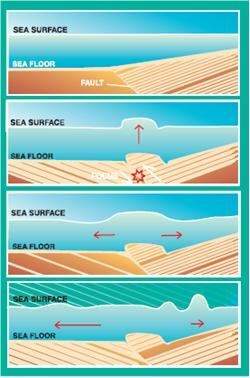
LANDSLIDE GENERATED TSUNAMI
Landslides (both submarine and subaerial), which often occur during a large earthquake, can also create a tsunami. During a submarine landslide, the equilibrium sea level is altered by sediment moving along the sea floor.
VOLCANO GENERATED TSUNAMI
A violent marine volcanic eruption too can create an impulsive force that displaces the water column and generates a tsunami.
IMPACT GENERATED TSUNAMIS
Fortunately it is very rare for a meteorite or an asteroid to reach the Earth. No asteroid or meteorite has been documented to have generated a tsunami in recorded history. However, since evidence of the fall of meteorites and asteroids on Earth exists, some might have landed in oceans and seas, since 80% of the planet is covered by water. Their fall into oceans has the potential to cause tsunamis of cataclysmic proportions.
One of the most destructive tsunamis in recent history was generated along Chile’s coast by an earthquake in May 22, 1960 (Figure 2). Every coastal town between latitudes 36S and 44S was destroyed or severely damaged by the action of the tsunami and the earthquake. In Chile, the double combination of earthquake and tsunami produced more than 2,000 deaths, 3,000 injured, two million homeless, and damage worth $550 million (US). The tsunami caused 61 deaths in Hawaii, 20 in the Philippines, 3 in Okinawa, and more than 100 in Japan. The height of the waves ranged from 13 meters at Pitcairn Islands, 12 meters at Hilo, Hawaii, and 7 meters at several places in Japan, to minor oscillations in other areas.

One of the most interesting landslide generated tsunamis happened in 1958 where about 81 million tones of ice and rock crashed into Lituya Bay, Alaska, Fifuren3). An earthquake had shaken the enormous mass loose. The landslide created a tsunami which sped across the bay. Waves splashed up to an astonishing height of 350 to 500 metres – the highest waves ever recorded. They scrubbed the mountain slope clean of all trees and shrubs. Miraculously, only two fishermen were killed.
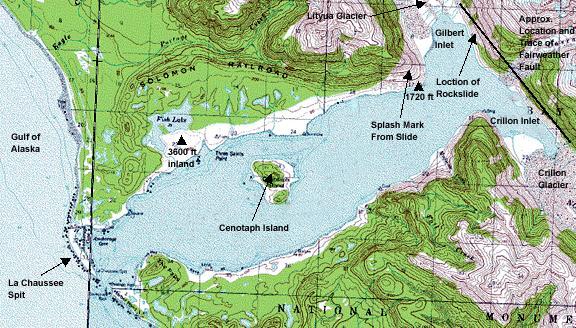
In 1883, a series of volcanic eruptions at Krakatau in Indonesia created a powerful tsunami. As it rushed towards the islands of Java and Sumatra, it sank more than 5,000 boats and washed away many small islands. Waves as high as a 12-story buildings wiped out nearly 300 villages and killed more than 36,000 people. Scientist believe that the seismic waves traveled two or three times around the Earth.

In 1997, scientists discovered evidence of an asteroid with a four kilometre (2.5 mile) diameter that landed offshore of Chile approximately two million years ago, producing a huge tsunami that swept over portions of South America and Antarctica. Scientists have concluded that the impact of a moderately large asteroid, five to six kilometres (three to four miles) in diameter, falling between the Hawaiian islands and the west coast of North America would produce a tsunami that would attack cities on the west coasts of Canada, the United States and Mexico and would cover most of the inhabited coastal areas of the Hawaiian islands. (“Tsunami Teacher”, Educational material prepared by UNESCO-IOC www.unesco.org)
It has not happened, but conceivably, a tsunami could also be generated by very large nuclear explosions.
The Pacific is by far the most active tsunami zone, according to the U.S. National Oceanic and Atmospheric Administration (NOAA, www.noaa.gov). But tsunamis have been generated in other bodies of water, including the Caribbean and Mediterranean Seas and the Indian and Atlantic Oceans. North Atlantic tsunamis included the tsunami associated with the 1775 Lisbon earthquake that killed as many as 60,000 people in Portugal, Spain, and North Africa. This quake caused a tsunami as high as 7 meters in the Caribbean.
The Caribbean has been hit by 37 verified tsunamis since 1498. Some were generated locally and others were the result of events far away, such as the earthquake near Portugal. The combined death toll from these Caribbean tsunamis is about 9,500.
The Mediterranean, Black and Red Seas are the second most common tsunami source region after the Pacific with 98 observed tsunamis. Tsunami warning systems in this region must deal with local tsunamis that will hit coasts within a few minutes. Perhaps the most famous tsunami, though not well verified, involved the disappearance of the island of Santorini in 1400 BC that is estimated to have caused 100,000 deaths.
The devastating mega thrust earthquake (Indonesia/ Nicobar/ Andaman/ Sumatra Earthquake) of December 26, 2004, occurred on Sunday, December 26, 2004 at 00:58:53 GMT (7:58:53 AM local time at epicenter) with Mw=9.0 NEIC Epicenter Latitude 3.32 North, Longitude 95.85 East (USGS) or 3.09N, 94.26E southwest Banda Aceh in Northern Sumatra (Borrero, 2005). The earthquake has also triggered giant tsunami and the tsunami waves that propagated throughout the Indian Ocean and have caused extreme inundation and extensive damage, loss of property and life along the coasts of 12 surrounding counties in the Indian Ocean. The loss of lives has also been extended to the people from totally 27 countries from other parts of the world. (www.yalciner.metu.edu.tr/malaysia).
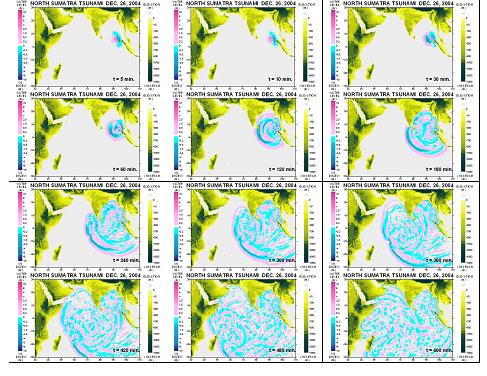
The destruction caused by tsunamis stems mainly from the impact of the waves, the flooding, the erosion of shorelines, foundations of buildings, bridges and roads. Damage is magnified by floating debris, boats and cars that crash into buildings. Strong currents sometimes associated with tsunamis, add to the destruction by freeing log booms, barges and boats at anchor. Additional damage takes the form of fires from tsunami-related oil spills and of pollution from released sewage and chemicals. The above results in loss of life, socio-economic, environmental and cultural heritage resources.
| Country | Dead | Missing |
|---|---|---|
| Indonesia | 125,598 | 94,574 |
| Thailand | 5,395 | 3,001 |
| Sri Lanka | 30,957 | 5,637 |
| India | 10,749 | 5,640 |
| Myanmar | 61 | – |
| Maldives | 82 | 26 |
| Malaysia | 68 | – |
| Somalia | 298 | – |
| Tanzania | 10 | – |
| Bangladesh | 2 | – |
| Kenya | 1 | – |
| TOTAL | 173,221 | 108,878 |
There are three factors of destructions from tsunamis: inundation, wave impact on structures, and erosion. Agricultural areas are fully flooded and destroyed beyond recovery for many years to come. Strong, tsunami-induced currents lead to the erosion of foundations and the collapse of bridges and seawalls, infrastructures. Flotation and drag forces move houses and overturn railroad cars. Considerable damage is caused by the resultant floating debris, including boats and cars that become dangerous projectiles that may crash into buildings, break power lines, and may start fires. Fires from damaged ships in ports or from ruptured coastal oil storage tanks and refinery facilities can cause damage greater than that inflicted directly by the tsunami. Of increasing concern is the potential effect of tsunami draw down, when receding waters uncover cooling water intakes of nuclear power plants. For 2004 Indian Ocean Tsunami total destruction figures are presented below:

Tsunami impacts on the environment in many ways, from the death of marine life to the destruction of livestock, plant life and the impact on geological features as well as damage to mangroves, coral reefs and vegetation. Of great concern are damage to marine habitats and the impacts on coastal towns that are intertwined with fragile marine systems.
Tsunami-induced environmental problems include:
- Ground water contamination.
- Damage to coral reefs, sea grass beds and mangrove ecosystems. o Salinisation of soils and damage to vegetation and crops.
- Tsunami-generated waste and debris. o Impacts on sewage collection and treatment systems.
- Damage to protected areas. o Coastline erosion and inundation.
- Changes in river hydrology.
- Loss of livelihoods based on natural resources or ecosystem services.
Archaeological sites, historical ruins, naturally beautiful places are lost under the impact of tsunami forces and due to inundation.
Yes: while these natural disasters cannot be prevented, their results (such as loss of life and property) can be reduced by proper planning.
For that, however, one must have a good understanding not only of the physical nature of the phenomenon and its manifestation in each geographical locality but also of that area’s combined physical, social and cultural factors. Some of these areas are more vulnerable to tsunamis than others. Because tsunami frequency in the Pacific Ocean is high, most efforts in hazard management have concentrated in this area of the world. No matter how remote, the likelihood of a tsunami should be considered in developing coastal zone management and land use.
While some degree of risk is acceptable, government agencies should promote new development and population growth in areas of greater safety and less potential risk. These agencies should formulate land-use regulations for a given coastal area with the tsunami risk potential in mind, particularly if such an area is known to have sustained damage in the past. Also, destruction of natural vegetation such as mangroves which act as a natural barrier against tsunami should be avoided. High rise building in the high risk areas increases the damage risk.
Tsunami early warning systems detect potentially dangerous earthquakes and may provide immediate early warning to countries that might be hit. Coordination of these global warning systems has been undertaken by UNESCO’s Intergovernmental Oceanographic Commission (IOC, http://www.ioc-tsunami.org) supported by its International Tsunami Information Centre. Building upon its experience in the Pacific, the IOC has also been helping to establish tsunami warning capabilities in the Indian Ocean, Caribbean, Atlantic and Mediterranean.
No, since the generative causes of a tsunami are mainly natural processes that to date occur unpredictably, such as earthquakes, landslides and volcanic eruptions. But conceivably tsunami waves could be generated by very large nuclear explosions, which has not happened till this day.
Given our current inability to forecast earthquakes and landslides (see also earthquakes & landslides modules) and the very limited predictive capacity to forecast volcanic eruptions (see module on volcanoes), it is virtually impossible to forecast tsunamis at this time.
However, by looking at past tsunamis, scientists know where tsunamis are most likely to be generated and potential impact areas. These potential impact areas are associated to geologically active zones that bear earthquake and volcano hazards. But not every earthquake, volcanic eruption or landslides necessarily trigger tsunamis. Past tsunami height measurements are also useful in predicting future tsunami impact and flooding limits in specific coastal locations and communities.
There is very little that can be done to prevent the occurrence of natural hazards (and in particular tsunamis). But humankind, being as adaptable as it is, has learned to live with all these hazards.
Proper planning of protective and preventive measures is a key factor to reduce losses due to this natural hazard. Present protective measures involve primarily the use of tsunami early warning systems employing advanced technological instrumentation for data collection and for warning communications. Countries like Japan, Russia, Canada and the United States have developed sophisticated warning systems and have accepted the responsibility to share warning information with other countries.
In 1965, UNESCO’s Intergovernmental Oceanographic Commission (UNESCO/IOC) accepted the United States’ offer to expand its existing tsunami centre in Honolulu to become the Pacific Tsunami Warning Center (PTWC, http://ptwc.weather.gov/ ). It also established an International Co-ordination Group (ICG/ITSU) subsequently renamed the Intergovernmental Coordination Group for the Pacific Tsunami Warning and Mitigation System (ICG/PTWS, and the International Tsunami Information Center (ITIC, http://itic.ioc-unesco.org/) to review the activities of the International Tsunami Warning System for the Pacific (ITWS).This set-up has facilitated collaboration at an international level and among many members of the Pacific region. The ICG/PTWS hold regular meetings to assess progress and activities offered by its service.
With 46 Member States (as of May 2018) from the Pacific and its marginal seas, the PTWS area of responsibility includes the Pacific Ocean, the Southern Ocean regions of the Pacific and all attached marginal seas, including the Philippine Sea, East China Sea, Yellow Sea, Sea of Okhotsk, Bering Sea, South China Sea, Java Sea, Arafura Sea, Sulawesi Sea, Mindanao Sea, Sulu Sea, Celebes Sea, Bismarck Sea, Solomon Sea, Coral Sea, and Tasman Sea.
Similar Tsunami Warning Systems also exist for the Indian Ocean (IOTWS) and the North Eastern Atlantic, The Mediterranean and Connected Seas (ICG/NEAMTWS).
One of the cornerstones of tsunami mitigation is hazard assessment: through this process, vulnerable coastal areas are mapped and the potential risk for people living there is identified.
The value of information was dramatically illustrated during the Indian Ocean tsunami. Most victims received no warning – but thousands of lives were saved in cases where tsunami knowledge existed and was used.
Experts have argued that tsunami warning systems need to be underpinned by public awareness campaigns and emergency response plans if they are to be effective.
Warnings are of little use if people do not know how to respond to them. Knowledge becomes even more critical if warning times are short – or there is no warning at all – in which case people must know how to react immediately.
The value of indigenous knowledge was highlighted by Simuelue islanders (Indonesia), who lost only seven of their 78,000 inhabitants even though the 2004 tsunami struck them just eight minutes after the earthquake. They have kept alive, through oral history, the lessons of a tsunami that struck in 1907 (known as “smong”): Simuelue islanders knew exactly what to do when the tsunami happened while populations of other nearby coastal areas were decimated.
A tsunami mitigation plan needs to:
- Quickly confirm potentially destructive tsunamis and reduce false alarms.
- Address local tsunami mitigation and the needs of coastal residents.
- Improve coordination and exchange of information to better utilize existing resources.
- Sustain support at state and local level for long-term tsunami hazard.
- Improve the awareness and preparedness of communities for tsunamis:
- Raise the awareness of affected populations.
- Supply tsunami evacuation maps.
- Improve tsunami warning systems.
- Incorporate tsunami planning into state and federal all-hazards mitigation programmes.
Civil defence authorities in each country can initiate public education programme consisting of seminars and workshops for responsible government officials, can publish informational booklets on the hazards of tsunami, and can co-ordinate with the communications media on the announcement of tsunami information. Other government agencies can take action also to mitigate future losses from tsunami. For example, government agencies can develop sound coastal management policies, which include zoning and planning for tsunami-prone coastal areas.
Internally, government agencies can streamline and co-ordinate their operating procedures and communications so they can perform efficiently when the tsunami threat arises. Procedures related to tsunami warnings should be reviewed frequently to define and determine better respective responsibilities between the different government agencies at all levels.
Scientific organizations can undertake research and engineering studies in developing evacuation zones or engineering guidelines for building coastal structures. Audio-visual materials can be prepared for educating children in schools and the public in general. Brochures and pamphlets can be printed describing the tsunami warning system and what the public can do in time of tsunami warning.
The natural environment can provide protection against tsunamis, and environmental destruction to make way for development can raise the tsunami risk of coastal communities. Tropical coastal ecosystems have sophisticated natural insurance mechanisms to help them survive the storm waves of typhoons and tsunamis such as coral reefs being equivalent of natural breakwaters causing waves to break offshore and allowing them to dissipate most of their destructive energy before reaching the shore.
Mangrove forests also act as natural shock absorbers, “soaking up destructive wave energy and buffering against erosion”. Systems of marshes, tidal inlets and mangrove channels also help limit the extent of inundation by floodwaters and enable flood waters to drain quickly.
Places that had healthy coral reefs and intact mangroves were far less badly hit than places where the reefs had been damaged and the mangroves ripped out and replaced by beachfront hotels and prawn farms during 2004 Tsunami.
However, there has been widespread destruction of natural coastal habitats to make way for urban development, population growth, industry, aquaculture, agriculture and tourism.
The World Wildlife Fund (WWF, http://www.worldwildlife.org) has recommended that tsunami mitigation strategies take into account:
- Rehabilitation and restoration of degraded coastal ecosystems that help protect from storm waves, especially coastal marshes and forests, mangroves and coral reefs.
- Adoption of integrated coastal zone management, including zoning and mandatory coastal setback. For example, hotels should not be built within a safety zone from the high tide mark.
- Strict enforcement of land and coastal-use planning and policies, including natural disaster risk assessments.
- Implementation of incentives to ensure that sensitive facilities are built away from high risk areas.
- Risk assessment that helps reduce the vulnerability of coastal development.
A heightened community awareness of the potential threat of tsunami can be achieved through a public education programme consisting of seminars and workshops for responsible government officials, informational booklets on the hazards of tsunami and what must be done in case of a tsunami.
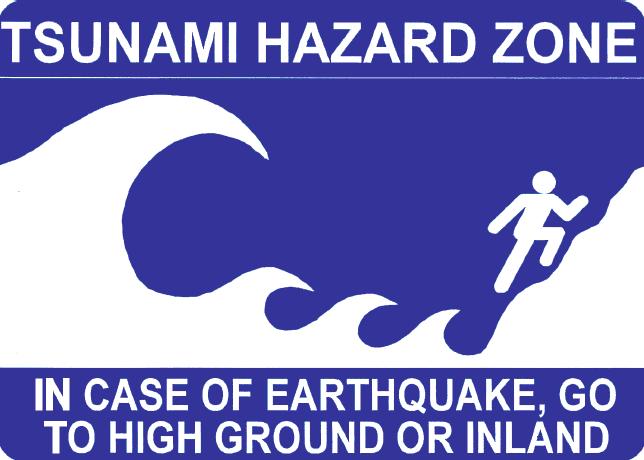
- A strong earthquake felt in a low-lying coastal area is a natural warning of possible, immediate danger. Keep calm and quickly move to higher ground away from the coast.
- Tsunamis can occur at any time, day or night. They can travel up rivers and streams that lead to the ocean.
- A tsunami is not a single wave, but a series of waves. Stay out of danger until an “ALL CLEAR” is issued by a competent authority.
- Approaching tsunamis are sometimes heralded by noticeable rise or fall of coastal waters. This is nature’s tsunami warning and should be heeded.
- A small tsunami at one beach can be a giant a few miles away. Do not let modest size of one make you lose respect for all.
- Sooner or later, tsunamis visit every coastline around the ocean.
- All tsunamis, like hurricanes, are potentially dangerous even though they may not damage every coastline they strike. • Never go down to the beach to watch for a tsunami! • WHEN YOU CAN SEE THE WAVE YOU ARE TOO CLOSE TO ESCAPE.
- Tsunamis can move faster than a person can run!
- During a tsunami emergency, your local emergency management office, police, fire and other emergency organizations will try to save your life. Give them your fullest cooperation.
- Homes and other buildings located in low lying coastal areas are not safe. Do NOT stay in such buildings if there is a tsunami warning.
- The upper floors of high, multi-story, reinforced concrete hotels can provide refuge if there is no time to quickly move inland or to higher ground.
- Stay tuned to your local radio, marine radio, NOAA Weather Radio, or television stations during a tsunami emergency – bulletins issued through your local emergency management office and National Weather Service offices can save your life.
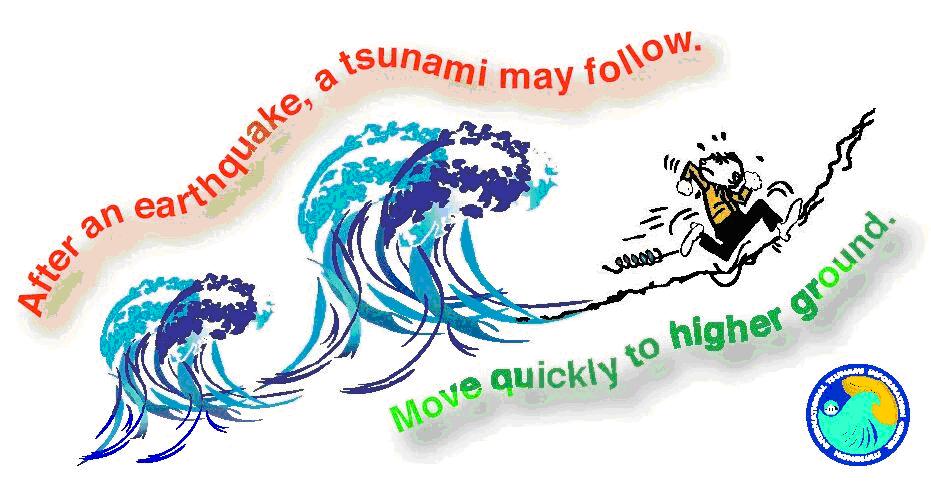
- Since tsunami wave activity is imperceptible in the open ocean, do not return to port if you are at sea and a tsunami warning has been issued for your area. Tsunamis can cause rapid changes in water level and unpredictable dangerous currents in harbours and ports.
- If there is time to move your boat or ship from port to deep water (after a tsunami warning has been issued), you should weigh the following considerations:
- Most large harbors and ports are under the control of a harbor authority and/or a vessel traffic system. Keep in contact with the authorities should a forced movement of vessel be directed.
- Smaller ports may not be under the control of a harbor authority. If you are aware there is a tsunami warning and you have time to move your vessel to deep water, then you may want to do so in an orderly manner, in consideration of other vessels.
- Damaging wave activity and unpredictable currents can affect harbors for a period of time following the initial tsunami impact on the coast. Contact the harbor authority before returning to port making sure to verify that conditions in the harbor are safe for navigation and berthing.
While one coastal community might experience no damaging waves during a tsunami, another community close by might be violently attacked and devastated.
Computer modeling of potential tsunami inundation – the horizontal inland penetration of waves from the shoreline – can reveal areas that are likely to be flooded during a tsunami (allowing the production of hazard / vulnerability maps), and what routes people can confidently use to reach pre-determined safe areas (used for development of evacuation maps).
Maps outlining tsunami inundation zones – areas likely to be flooded by the great waves – can assist planners and decision makers in designating evacuation zones and routes to safety.
For this, observations of run-up and inundation from past events are essential to validate modeling-based inundation maps.
One of the key tools for tsunami mitigation is the study and production of hazard maps of local coastal areas to ascertain how vulnerable they are to tsunamis – this can vary greatly along shorelines depending on the intensity of the waves, undersea features and the topographical lay of the land.
Hazard maps require knowledge of the historical tsunami record in order to estimate the probability that a tsunami will occur in the future. An integral part of emergency preparedness is understanding the tsunami hazard or threat. Since earthquakes are the most probable source, seismic hazard maps are needed to identify the potential earthquake source zones. In the case of tsunamis, this also includes trying to predict the potential height of waves.
In high-risk areas where the maximum potential source of a tsunami is known – for example if there is an active earthquake subduction zone offshore – tsunami generation, propagation and run-up can be mathematically modelled and wave heights estimated. Also, historical records of previous tsunamis charting earthquake magnitudes, and wave heights and run-up and inundation patterns, can be used to support tsunami hazard predictions.
One such study as outlined previously was performed for Istanbul, Turkey (Figure 1). Comprehensive tsunami simulations were based on 49 different scenarios considering not only active faults but also submarine landslide induced tsunamis by using OIC, a widely accepted, scientifically verified tsunami simulation code TUNAMI N2. The animations of the selected scenarios have been prepared by METU, The Department of Civil Engineering, Ocean Engineering Research Center using the tsunami simulation and visualization code NAMI DANCE, which has been developed for tsunami numerical modeling and simulations by Profs..Nobuo Shuto and Fumihiko Imamura in Tohoku University Japan. TUNAMI N2 determines the tsunami source characteristics from earthquake rupture characteristics. It computes all necessary parameters of tsunami behavior in shallow water and in the inundation zone allowing for a better understanding of the effect of tsunamis according to bathymetric and topographical conditions. For further information, http://yalciner.ce.metu.edu.tr/marmara/index_eng.htm
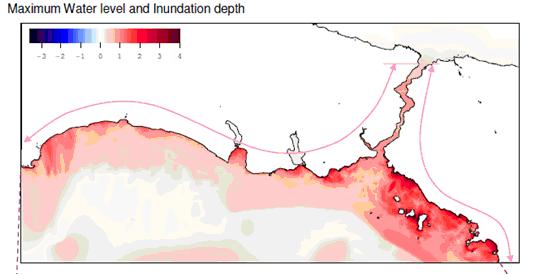
Tectonically induced tsunamis occur in Europe mainly in the Mediterranean and the Black Sea. There are several geological and historical records of tsunamis (see above). The most endangered zones lie in close vicinity to the main volcanoes or along seismically active zones. Tsunamis caused by (submarine) landslides have mainly occurred in Norway, but also in some other areas in Europe (Figure 1). Often it is difficult to distinguish if an earthquake caused a tsunami or if an earthquake triggered a (submarine) landslide that then caused a tsunami. In general it can be concluded that tsunamis are possible along all shorelines that lie in tectonically active zones and/or in areas where (submarine) landslides are possible. Even though no devastating tsunamis have occurred in Europe in the last 100 years, the potential hazard is still high. (http://www.gsf.fi/projects/espon/Tsunamis.htm)
